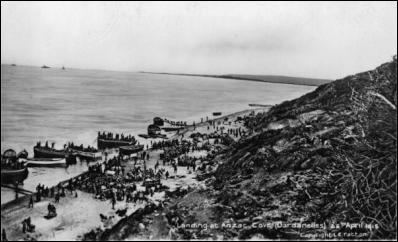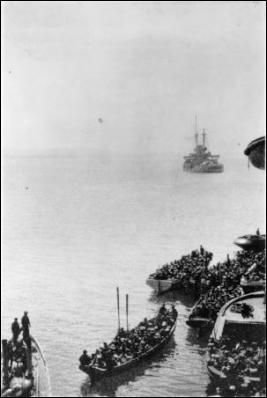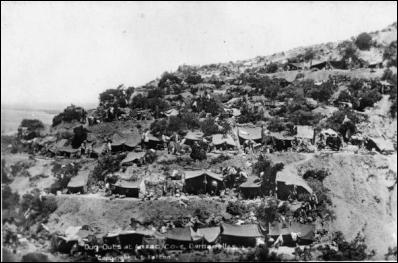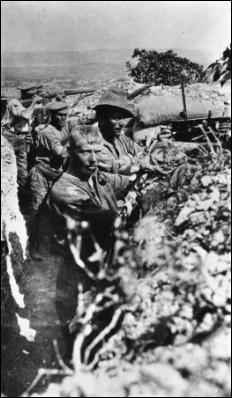Remembering The Fallen At ANZAC Cove Gallipoli
Remembering The Fallen At ANZAC Cove Gallipoli
By Selwyn Manning – Scoop Co-Editor.
-------
Historical facts sourced and quoted from the works of New Zealand historian Ian McGibbon, see… The Gallipoli Campaign, www.nzhistory.net.nz - Black and white historical photographs courtesy of Alexander Turnbull Library…
-------

Scoop Image: ANZAC Cove,
Gallipoli.
From their position the war was tight around them, they saw the beach, they saw the wounded, dead, friends, strangers, disorganisation, they lay, they huddled, they were seasick and tired and they had no perspective of the bigger picture that we see - thanks to the benefit of history.
If they could they would have seen officers and privates alike huddled about their solitary square yard, writing home to their loved ones: ‘I love you and am thinking of you, hoping and praying for the day we will be together again’.
It’s a sentiment I try to feel from this position 90 years on. I stand here at ANZAC Cove and look out upon the sea, imagining the boats charging to shore. I notice a skylark signing from a place where smoke once gathered. Today waves lap the shore without surge without hue and somewhere between the then and now there’s a strange surreal space that is almost palpable. Only while there does the true gravity of loss take its grip.

Scoop Image: Graves on the cliffs above ANZAC Cove.
For others it arrives later at the Dawn Service as the Last Post echoes through the hills while 20,000 mostly youthful people stand - a chilling wind silent as a spirit moves through the crowd. For others it arrives with the hymn Abide With Me. The reciting of the poem 90 Years Ago by Rupert McCall readies us all to the reading of a letter written by Lieutenant Colonel Malone (killed in action) to his wife. The words reach within all who have a heart, the well of emotion soothed by Albinoni’s sombre Adagio in G Minor. And I think of the experiences of battle, retold to me by a returned soldier known as Chino Mulligan (click here for his story…), how he spoke of fear and faith with an honesty that cast aside delusions of glory.
And out to sea, the Australian frigate ANZAC casts an eerie glow within this moonlit night.

Landing at Anzac Cove, Gallipoli, 25 April 1915. Photograph taken by L E Tatton.
Beaching on ANZAC Cove was a mistake that would be debated for decades: the Australian spearhead was misdirected by about two kilometres north of the planned landing place. As New Zealand historian Ian McGibbon writes: “The reasons for this have been hotly debated over the last eighty years, with tides, faulty navigation by the landing fleet, belated changes of orders all being canvassed. An unauthorised alteration of direction northwards by one of the midshipmen commanding a steamboat, which pulled the whole line of tows in this direction, is the most likely explanation.”

Auckland Battalion landing at Gallipoli at daylight, 25 April, 1915. Photographer unidentified.
On the first day about one in five of the 3000 New Zealanders who landed were either injured or dead. The Turks had taken the hilltops and the ANZACS were almost forced back into the sea. But by April 26 the ANZACs had dug in.

Dug-outs at Anzac Cove, Gallipoli, Turkey, 1915. Photograph taken by L E Tatton.
On May 6 a frontal assault in daylight was initiated but the soldiers were soon halted. Many were killed without any sign of a breakthrough being possible. The kiwis were told to take part in an attack on May 8 but they had little time to prepare. Again Ian McGibbon writes: “Their attack went in behind a weak artillery bombardment at 10.30 a.m. The Wellington Battalion, on the left, got the furthest forward, advancing several hundred metres before being brought to a halt. Ordered to renew the attack at 5.30 p.m., the New Zealand troops again suffered heavily as they struggled across the Daisy Patch.

Men in the trenches scoping out the lie of the land during the campaign at Gallipoli during World War I. Taken by an unidentified photographer in 1915.
“The Australian brigade, suddenly ordered to advance as well, could make no progress either. The three-day operation, later designated the Second Battle of Krithia, had cost the Allies 6500 men in gaining about half a kilometre of ground of no major significance. The New Zealand Brigade lost more than 800 men in this ill-conceived attack.”
On 19 May the ANZACs faced a surge of 40,000 Turks: “In the New Zealand sector, the troops defending Russell's Top beat off repeated attacks from the Nek, while the Australians did the same further south. No man's land was left strewn with an estimated 10,000 Turkish casualties, including 3000 dead,” Ian McGibbon writes.
A brief truce followed that allowed some of the dead to be buried. Once the grisly task was completed a stalemate ensured. ANZACs and Turks faced each other often only metres apart. Summer heat, flies from the dead, a shortage of water led to dysentery and malnutrition.
August loomed and plans of an advance on Gallipoli’s high ground took shape with an objective to capturing Chunuk Bair, Hill Q, and Hill 971. The Australians offered a diversion at Lone Pine (seven Australians were awarded the Victoria Cross) and at dawn on August 7 an attack was launched by the New Zealanders from Chunuk Bair.

Members of the Wellington Machine Gun Section at The Apex, Gallipoli, Turkey, August 1915. The man with pipe is Robert William Dyer. Photographer unidentified.
Ian McGibbon writes: “As soon as night fell, two covering forces moved out to capture the foothills through which the assaulting columns would move to secure their objectives. On the right, the New Zealand Mounted Rifles Brigade and Otago Mounted Rifles had secured their objectives by 1 a.m. The plan thereafter came unstuck. Proceeding up separate deres (valleys), the two elements of the right assaulting column, which consisted of Johnston's New Zealand Infantry Brigade and an Indian mountain battery, were supposed to rendezvous on Rhododendron Spur before moving up on to the summit of Chunuk Bair. At dawn Johnston was still waiting at the Spur for part of his column to come up; when ordered to attack immediately he did so half-heartedly and was repulsed by the comparatively weak Turkish forces on the summit.”

Probably soldiers of the Wellington Mounted Rifles, New Zealand Expeditionary Force, occupying a trench on Table Top, Gallipoli, during the night of August 6. 1915, in preparation for the attack on Chunuk Bair. Photograph taken by James Cornelius Read.
British and Indian troops failed to make ground over the rugged terrain in the darkness. There was to be no converging attack from Chunuk Bair. The 3rd Australian Light Horse Brigade was in effect sacrificed in the hope that the attack might help the assaulting columns up on to their objectives by distracting the enemy.
“The overall plan had depended upon speed, to ensure that the troops on the summits could consolidate their positions before the Turks could deploy their reserves in response. The delays had fatally compromised the whole offensive, though on the 8th a glimmer of hope was provided when Johnston's column found Chunuk Bair unoccupied and the Wellington Battalion moved quickly on to the summit. But the position was enfiladed by Turks on other high points, and after dawn they prevented significant reinforcements getting up to join the Wellingtons. Not until after dark did the Otago Battalion and the Wellington Mounted Rifles join them. “A further attempt to seize Hill Q was made on 9 August, but once again the whole enterprise was fatally compromised by a lack of coordination. Even so, a small force of Gurkha soldiers managed to reach the top of Hill Q, but were unable to consolidate their position before falling back after being hit by friendly naval gunfire. “By this time the weight of Turkish pressure was beginning to make itself felt, as reinforcements arrived. In desperate fighting, the New Zealanders on the summit of Chunuk Bair held off the Turks for two days. But on 10 August a massive Turkish counter-attack settled the issue. The British battalions which had relieved the New Zealanders on Chunuk Bair the previous night were swept away. The British forces on the approaches to Hill Q were also driven back,” Ian McGibbon wrote.
Mid September saw the New Zealanders withdrawn to Lemnos for rest and reorganisation. By the time they returned to Anzac in November, the future of the campaign had been sealed.
The withdrawal took place on December 19-20.


 Eugene Doyle: The Fall Of Saigon 1975 - Fifty Years Of Repeating What Was Forgotten
Eugene Doyle: The Fall Of Saigon 1975 - Fifty Years Of Repeating What Was Forgotten Peter Dunne: Dunne's Weekly - Trump's Tariffs Still Pose Risks For New Zealand
Peter Dunne: Dunne's Weekly - Trump's Tariffs Still Pose Risks For New Zealand Keith Rankin: Barbecued Hamburgers And Churchill's Bestie
Keith Rankin: Barbecued Hamburgers And Churchill's Bestie Gordon Campbell: On Why The US Stands To Lose The Tariff Wars
Gordon Campbell: On Why The US Stands To Lose The Tariff Wars Eugene Doyle: Before It’s Too Late - Reimagine New Zealand’s Military Future
Eugene Doyle: Before It’s Too Late - Reimagine New Zealand’s Military Future  Binoy Kampmark: Gender Stunts In Space - Blue Origin’s Female Celebrity Envoys
Binoy Kampmark: Gender Stunts In Space - Blue Origin’s Female Celebrity Envoys